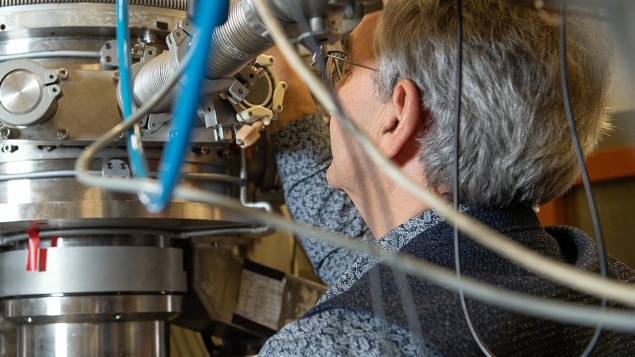Evidence grows for tetraneutrons as hypothetical clusters are glimpsed in Germany
14 Dec 2021 Hamish Johnston
The tetraneutron, a hypothetical cluster of four bound neutrons, has been glimpsed by physicists in Germany. Although the measurement is well below the statistical significance required for a discovery, the observation is the latest possible sighting of the tetraneutron in the past two decades. Confirming the existence of the tetraneutron would shake-up our understanding of the forces that bind nuclei together and could also provide insights into neutron stars.
For over 50 years, physicists have been looking for clusters of two or more neutrons that are bound together by the strong force – and have found no conclusive evidence for their existence. There have been, however, tentative sightings of tetraneutrons, comprising four neutrons.
In 2002 an experiment at the GANIL accelerator facility in France revealed the first evidence for tetraneutrons – be it fleeting. Then in 2016, tetraneutrons were glimpsed again at the RIKEN nuclear-physics lab in Japan. The Riken team concluded that the tetraneutron is unbound, meaning that it immediately flies apart after being produced. A year later, physicists in the US and France developed a theoretical framework that suggested that if tetraneutrons existed, they would not stick around for very long. As a result, it remains unclear whether bound tetraneutrons exist.
Stable as a neutron
The latest search for was led by Thomas Faestermann and used the tandem Van de Graaff accelerator at the Maier-Leibnitz Laboratory, which is on the Garching campus of the Technical University of Munich. The team fired lithium-7 ions at a target of lithium-7 and observed the particles created by the colliding lithium nuclei. They found that some of the collisions created a carbon-10 nucleus along with a tetraneutron. The data suggest that the binding energy of the tetraneutron is about 420 keV. Calculations by the team suggest that the tetraneutron is roughly as stable as a free neutron, which has a half life of 450 s.READ MORE

“For us, this is the only physically plausible explanation of the measured values in all respects,” explains Faestermann.
The measurement has a statistical significance of 3σ. However, this is not good enough for particle physics, which normally requires 5σ for a discovery. The team is now hoping that their measurements and analysis can be confirmed by independent groups.
The research is described in Physics Letters B.

Hamish Johnston is an online editor of Physics World
from physicsworld.com 17/12/2021

Δεν υπάρχουν σχόλια:
Δημοσίευση σχολίου